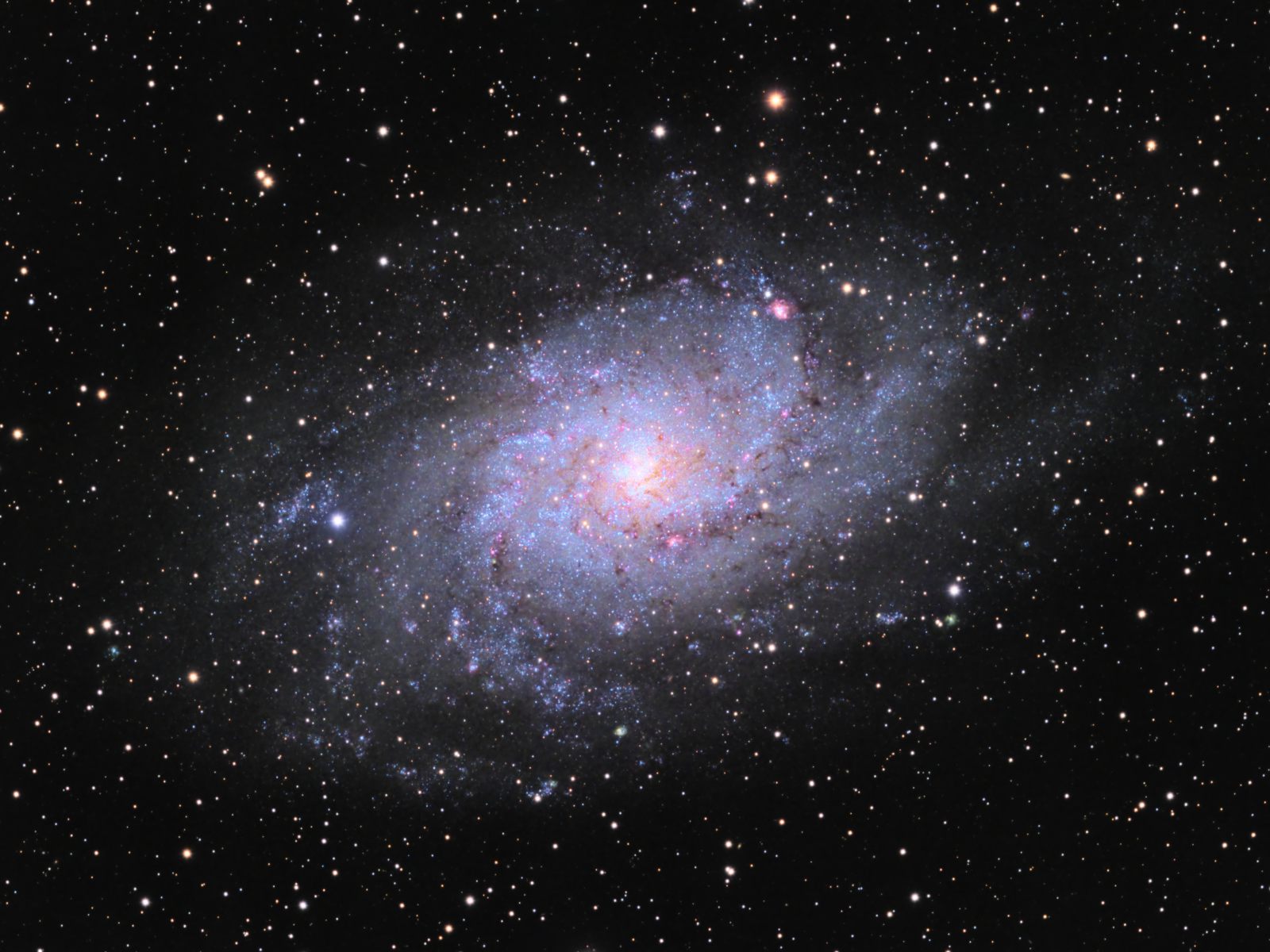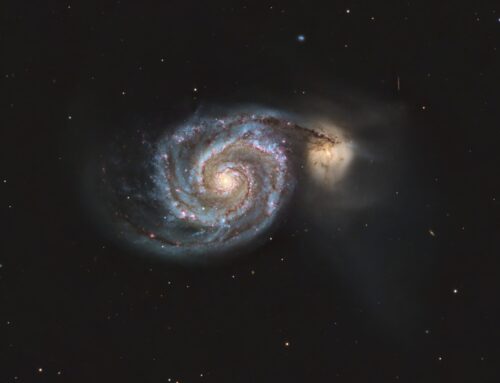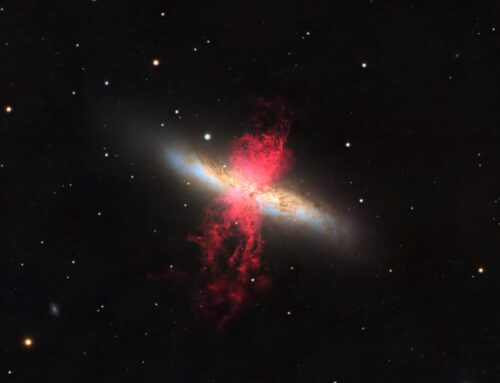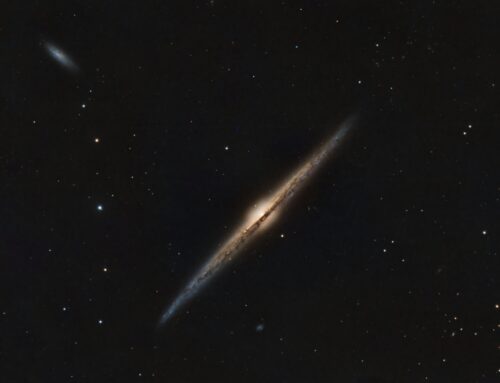M33, Triangulum Galaxy
 Click image for full size version
Click image for full size version
January 21, 2019
M33, the Triangulum Galaxy, is one of the closest large galaxies to Earth. It’s visible to the naked eye in a dark sky, and is a fine sight in a large telescope. It lies in the constellation Triangulum around 2.5 million light years distant and has a diameter of around 60,000 light years. M33 lies not far in the sky from another big, beautiful galaxy: M31.
Because of its size and relative closeness to us, M33 displays a wealth of detail in photographs. Even through the eyepiece some of the brighter knots of star clusters and glowing nebulae stand out enough that they were given individual catalogue numbers.
A hydrogen alpha filter was used to capture the deep red light emitted by nebulae in M33. These structures are similar to our Milky Way’s Orion Nebula. The image also highlights the star-rich core of M33, encircled by dark dust lanes. I’ve made an annotated photo that shows numerous catalogued nebulae and star clusters in M33 and many other galaxies in the field.
I seem to image this galaxy with every different imaging setup that I try. My previous image, from last winter, used a much shorter focal length telescope. In 2015, Terry Hancock and I collaborated on an image of M33.
Tekkies:
Sky-Watcher Esprit 150 f/7 refractor, QHY 16200-A camera, Optolong Ha, L, R, G and B filters, Paramount MX. Acquisition with TheSkyX unguided. Focused manually using a Bahtinov mask. Automation with CCDCommander. All pre-processing and processing in PixInsight. Acquired from my SkyShed in Guelph. No Moon for L, moderate moonlight for Ha and RGB, averagetransparency and fair to average seeing. Data acquired Nov. 4, 2018 – January 13, 2019.
75x5m L, 24x5m R, G and B, and 7x10m Ha (Total = 13hr25m)
Image scale 1.15 arcsec per pixel
Data Reduction and Cleanup
The BatchPreProcessing script was used to perform calibration, cosmetic correction and registration of all frames. ImageIntegration was used to make the L, Ha, R, G and B masters. DynamicCrop was used to crop all the masters identically. DynamicBackgroundExtraction was applied to each master twice, with Division followed by Subtraction.
RGB
Creation and cleanup: The R, G and B were combined to make an RGB image which was processed with PhotometricColorCalibration.
Linear Noise Reduction: MultiscaleLinearTransform was used to reduce noise in the RGB image. Layer settings for threshold and strength: Layer 1: 4.0 0.8 Layer 2: 3, 0.7 Layer 3: 2., 0.6 Layer 4: 1.0, 0.2 Layer 5: 0.5, 0.1.
Stretching: HistogramTransformation was applied to make a pleasing, bright image, with background set to an intensity of approximately 0.08.
Luminance
Creation and cleanup of SynthL: The L, R, G and B masters were combined using ImageIntegration (average, additive with scaling, noise evaluation, iterative K-sigma/biweight midvariance, no pixel rejection).
Deconvolution: A star mask was made to use as a Local Deringing Support image. A copy of the image was stretched to use as a range mask. Deconvolution was applied (80 iterations, regularized Richardson-Lucy, external PSF made using PSFImage script with about 30 stars).
Linear Noise Reduction: MultiscaleLinearTransform was used to reduce noise in the background areas, using an internal mask to protect bright structures. Layer settings for threshold and strength: Layer 1: 3.0 0.9 Layer 2: 2.0, 0.75 Layer 3: 1.0, 0.6 Layer 4: 0.5, 0.2.
Stretching: HistogramTransformation was applied to make a pleasing, bright image, with background set to an intensity of approximately 0.08.
H-alpha
Deconvolution: A star mask was made to use as a Local Deringing Support image. A copy of the image was stretched to use as a range mask. Deconvolution was applied (50 iterations, regularized Richardson-Lucy, external PSF made using DynamicPSF tool with about 20 stars).
Linear Noise Reduction: MultiscaleLinearTransform was used to reduce noise in the background areas of the Ha image. Layer settings for threshold and strength: Layer 1: 3.0 0.9 Layer 2: 2.0, 0.75 Layer 3: 1.0, 0.6 Layer 4: 0.5, 0.2.
Stretching: HistogramTransformation was applied to make a pleasing, bright image, with background set to an intensity of approximately 0.085.
Combining SynthL, RGB and Ha
SynthLRGB: The SynthL was applied to the RGB image using LRGBCombine with default settings.
SynthLHaRGB: PixelMath was used to add Ha to the RGB through a mask, which was a stretched clone of the H-alpha image, using the following expressions for the R, G and B channels:
R: max($T[0], 1.3*Ha)
G: $T[1]
B: iif($T[0]<Ha, $T[2] + 0.07*Ha, $T[2])
Additional Processing
Nonlinear Noise Reduction: TGVDenoise was used in L*a*b* mode to reduce noise in the background areas (max. 1000 iterations and convergence selected for both luminance and chrominance).
Sharpening: MultiscaleLinearTransform was used to sharpen Layers 2 and 3 (strengths of 0.1 for both. A mask was used to limit sharpening to high signal areas and to protect stars and background.
Contrast Enhancement: LocalHistogramEqualization was applied to the bright parts of the galaxy with a scale of 50 (max contrast 1.5, strength 0.7, 1 iteration), followed by a scale of 150 max contrast 1.5, strength 0.25, 1 iteration). A mask was used to protect background, dim galactic structures and stars. The DarkStructureEnhance script was applied with 8 layers and a strength of 0.2.
Final Steps: Background, galaxy and star brightness, contrast and saturation were adjusted in several iterations using CurvesTransformation with masks as required.






Leave A Comment